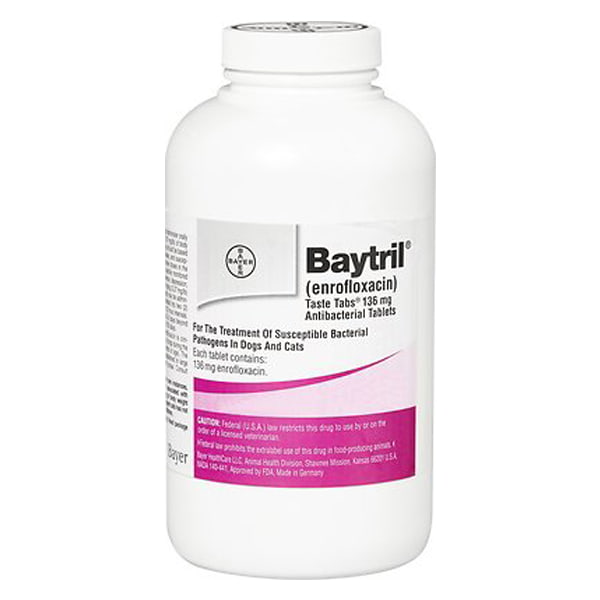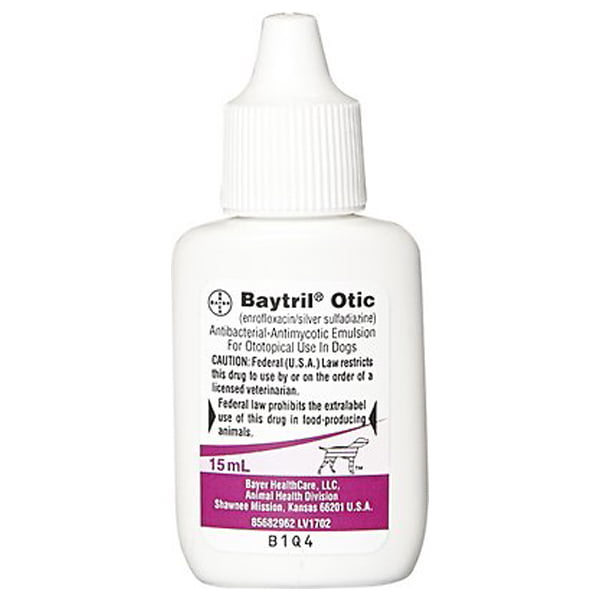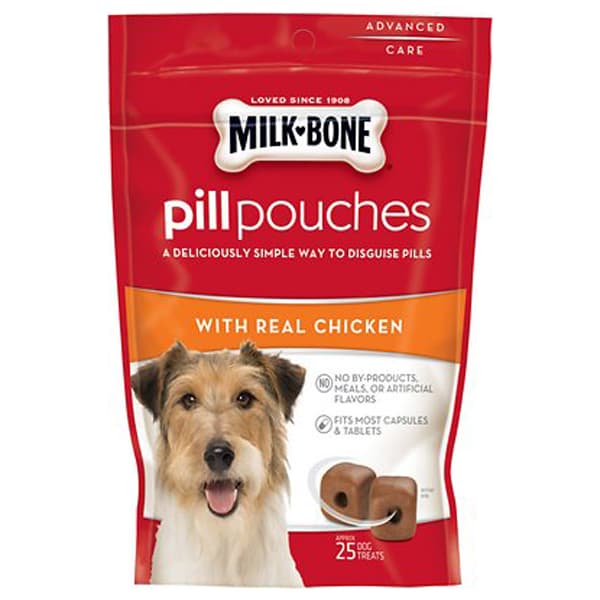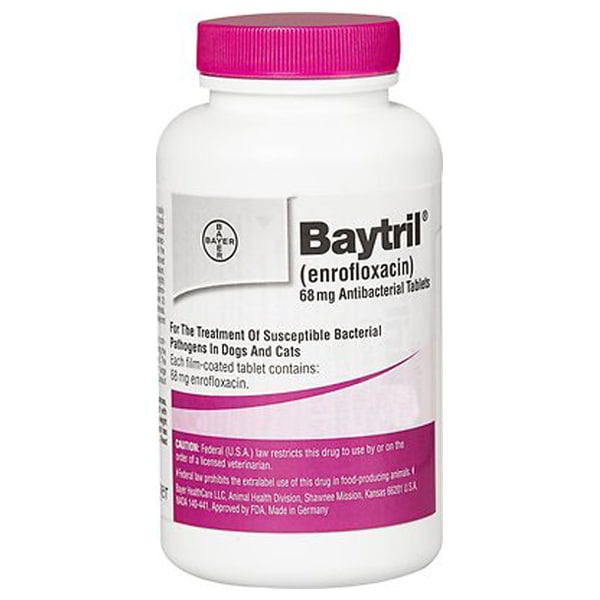Baytril is a less commercially known antibiotic than ones like amoxicillin and penicillin but is just as effective if not more so. Baytril, also known as Enrofloxacin, is a strong broad-spectrum fluoroquinolone antibiotic that is prescribed to treat bacterial infections that are not responding to other treatments or need immediate intervention. This drug is specifically designated for dogs and cats and is toxic to humans. It works against Gram-negative and Gram-positive bacteria specifically targeting Pseudomonas and Staphylococcus. It is often used to combat skin, ear, urinary and respiratory infections that are stubborn or were caught farther along in their infection status. Baytril is also used to get rid of numerous other bacterial infections that may infect your pup.
Baytril is a stronger antibiotic than most and works by stopping infecting bacteria from transcribing DNA – it will not allow the bacteria to be replicated. It halts the enzyme that is linked with this replication job from reading or unwinding the DNA. By stopping this task, the bacteria die. The secondary benefit of Baytril is that it is quickly absorbed through the dog’s GI tract and goes into all body tissue and fluid allowing it to work quickly at stopping the bacteria.
The capabilities of Baytril are positive as it can begin killing bacteria as soon as 20 minutes after they are exposed to the drug. It also is quick to exterminate both Gram-positive and negative bacteria. Numerous studies have shown that it also has good bactericidal tendencies especially in the growth and stationary stages when bacteria are replicating. It kills bacteria much faster than other antibiotics.
Baytril for Dogs Usage

Baytril’s strength is found by getting tough with pesky bacterial infections that are not always affected by other antibiotics. It has a far-reaching range of abilities. The fact that it is broadly based allows it to fight off bacteria that are both minor and major.
Baytril can be used to treat the following:

Baytril comes in multiple formats. It is a tablet form as well as a drop formula for combatting ear infections. It has doses that range from 22.7mg to 136mg in scored tablet form. The dose your vet will choose will be the most appropriate as calculated according to 2.27mg-9.07mg per pound of body weight. Your vet will assess this amount by looking at your dogs’ size, overall health, and current illness. This daily dosage is then halved and given every 12 hours. If they are also taking sucralfate or antacids, you can’t administer Baytril within 2 hours of those doses. There are also restrictions on the administration if your dog has had dairy products, vitamins or minerals.
Once all these interactions issues have been addressed, your dogs’ dosages should be given on an empty stomach but if nausea is an issue it won’t be detrimental to the drug to have it with food to quell the stomach upset. It is just as important to make sure they have water as well, so they aren’t only helping the absorption rate but are expelling the bacteria through their urine and feces.
To make dosing easier, administer your dogs’ dose at a similar time every day. That will help you remember to do it as well as making sure your dog will have the same amount of medication in their system at all times while they heal. There will be no ups and downs in their blood, just a consistent dosage.
Many medications have suggested restrictions on which dogs can or can not take it. However, Baytril has strong precautionary guidelines that suggest there is little room to waver on some of the dogs that should not be ingesting it. Included in this list are:
In many cases with other antibiotics, vets would weigh the pros and cons but in the case of Baytril, side effects can be severe so there is less chance your dog will be taking it if they fall into the above categories. That’s not to say they won’t be prescribed it but if they are, you can have an informed conversation with your dog's vet as to why this choice is being made.
Baytril comes in three forms to fight bacterial infections. While the chewable tablets are easiest to administer with studies showing that almost 75% of dogs ate them with no issues, you can also use drops for ear infections and coated tablets with no taste. However, if your dog falls into the 25% of pups that wouldn’t eat the chewable or you need to give them the plain tablets, you may want to put them in a pill pocket to make it easier to get them to ingest the medication. Do not crush the tablets as they tend to have a bitter taste and your dog will not take them even if mixed into food.
Baytril for dogs is well known for its strength in combating tough to beat bacterial illnesses. As with any prescription drug, your dog’s veterinarian will know when best to give it to your pup. Once they begin taking it you will have to be aware of side effects and negative drug interactions that may occur if your pup is taking other medications. Both general side effects and negative interactions are listed to make sure your pup is safe when taking the medication.
Theses effects are listed for precautionary reasons in the hopes that should they occur the owner will seek treatment quickly as they will recognize them.
General Baytril side effects:
Baytril Allergy Side Effects:
A further note for safety purposes is that if Strep Canis has not been ruled out as the bacterial infection that your dog is suffering from, do not give your dog Baytril. For some yet undiscovered reason, enrofloxacin in Baytril may react to the Strep bacteria and can lead to necrotizing fasciitis also called flesh-eating disease. This potentially deadly reaction seems to be mainly present in Baytril but not other quinolone class antibiotics. If your vet is not sure what the underlying infection is then don’t choose Baytril until it is figured out.
A few of the general side effects can be minimized by combining food and meds. It will address some stomach and GI issues. Food is not a necessity but may help ward off nausea. Water will also help if taken alongside the dose by easing the swallowing of their pills. It's important to be aware if their side effects move beyond the general level and become more severe. If symptoms such as vomiting and diarrhea become acute, you need to take your dog to the vet as they could be suffering from an allergic reaction or an overdose.
Aside from these general and allergic reactions, Baytril has some medications that it is known to react badly with. The mix of certain drugs can cause a serious negative interaction so it's important that your dog's veterinarian know if they are taking any vitamins, minerals, herbal or natural supplements or other drugs. These other things do not have to be prescribed. It's best to tell the vet about all remedies both prescribed and ones you can buy on your own. Being proactive with this is important to the health of your dog and the ability of the medication to do what it should. Some of the drugs that need to be watched for are:
While this mix of named drugs doesn’t mean our vet won’t prescribe Baytril, it may mean that they will be extra cautious in giving it to them. They may ask you to adjust the timing of administering either Baytril or the interacting drug, so they aren’t overlapping as much in your dogs’ systems thereby diluting the strength or stalling one effect while the other works.

Some studies suggest that minerals such as iron, zinc, calcium, magnesium, and aluminum will hinder the effects of Baytril as they block its absorption so your vet must be aware of these as well or taking the medication will have little to no effect.
While all these named side effects can be troubling, the lists show there are ones that need to be managed more quickly compared to others. If you think there are issues of toxicity, overdose or allergic reaction then your dog needs to head back to their vet as soon as possible. Extreme reactions such as with anaphylaxis need to be addressed immediately and your dog should be taken to an emergency clinic if this is the case. The shut down of their airways due to a severe allergic reaction can not wait for treatment. They will have limited time to get help.
Product Image | Product Name | Buy Now |
|---|---|---|
Baytril (Enrofloxacin) Chewable Tablets for Dogs & Cats | ||
Baytril (Enrofloxacin / Silver Sulfadiazine) Otic Solution for Dogs, 15-mL | ||
Milk-Bone Pill Pouches with Real Chicken Dog Treats, 6-oz bag | ||
Baytril (Enrofloxacin) Tablets for Dogs & Cats |
Unfortunately, these lists of side effects can sound scary when all you want to do it see that your dog can begin to heal and feel better. In reality, these dire side effects are rare. While general side effects may rear their heads now and then, they often fade as your pup gets used to the medication. Baytril is FDA approved and has had numerous studies completed that prove it is a good medication that is highly successful in its treatment of bacterial infections. The side effect list is simply to highlight a warning for owners in case their dog is one of the few that reacts poorly to it. It's important that although your dog may not suffer any side effects at all, that you know what to look for in case they do at some point.
Final Thoughts
Baytril is a lesser-known medication that is highly successful in dealing with tough bacterial infections that aren’t responding to other antibiotics. It's fast absorption rate that allows a quick attack on bacteria is helpful when your dog is struggling to recover from an illness. While no one wants their pet to be sick, it happens and a quick response to it can reduce its impact on your pup. Whether it is a bug they picked up swimming in a pond, playing in the dog park or simply just going about their usual routine, Baytril will help combat whatever bacterial illness that has gotten into them.
If you think your pup seems off or see signs of a type of bacterial infection, go to the vets for a visit so your dog can be properly assessed, treated and monitored. It is never safe to give your dog human antibiotics so make sure to work with their vet to take care of whatever they have properly and safely. The more information your dog’s veterinarian can have, the better and quicker your dog can be treated. It doesn’t matter whether your dog has a simple infection or a bacterium that is entrenched deep within their system, diagnosis is critical so a proper treatment plan can be set up, and the administration of medication can start.









